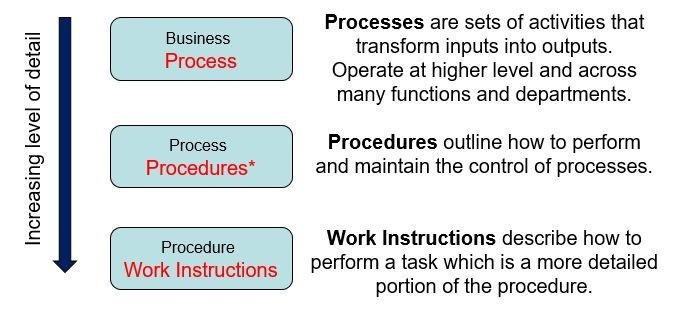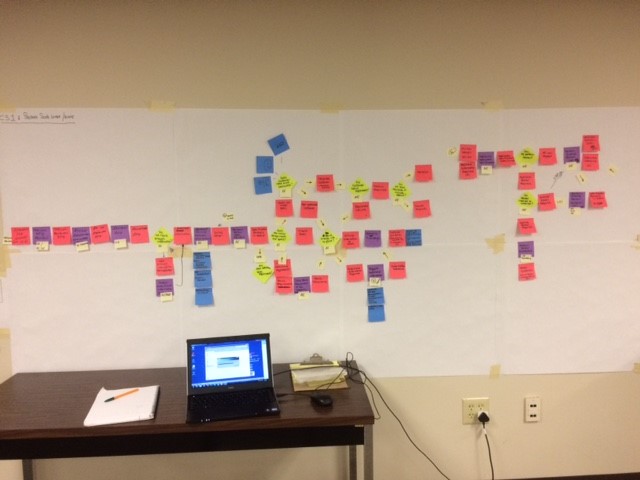Total Quality Management: an Early Adopter of the ISO Process Approach
Emma Harris
Total Quality Management (TQM) is an approach that focuses an organisation's efforts towards continually improving its ability to deliver high quality products and services to its customers.
TQM enjoyed widespread attention during the late 1980s and early 1990s, but since then it has been somewhat overshadowed by the ISO 9000 family as well as Lean and Six Sigma. However, it is worth spending time thinking about, both because its implementation is generally based on the 8 principles of quality management - which were later formalised by the ISO 9000 certification processes - and because TQM describes a management approach to long-term success through customer satisfaction.
Both ISO 9001 and TQM require all members of an organisation to participate in improving processes, products, services and the culture in which they work.
Adopting a process approach to achieving both ISO 9001 and TMQ delivers best results. The process approach is both one of the quality management principles (refined to 7 principles by ISO 9001:2015) and a way of achieving continual improvement.
This article sets out to explain the process approach and looks at some of the ways it can help you implement a TQM culture, achieve ISO 9001:2015 certification and some examples of how to fix problems that may exist around achieving your quality objectives. Use the links below if you would like to jump to a specific section:
- The Process Approach
- Quality First Time with the Process Approach
- Focus on the Customer
- Strategic Improvement Approach
- Continually Improve Your Business
- Teamwork: Mutual Respect and Collaboration
The Process Approach
'The process approach includes establishing the organisation’s processes to operate as an integrated and complete system:
- The management system integrates processes and measures to meet objectives
- Processes define interrelated activities and checks, to deliver intended outputs
- Detailed planning and controls can be defined and documented as needed, depending on the organisation’s context'
This definition is set out in ISO/TC 176/SC 2/N1289 - an ISO guidance paper entitled, 'The Process Approach in ISO 9001:2015'.
A very flexible approach therefore... and powerful as, 'risk‐based thinking is used throughout the process approach to:
- Decide how risk (positive or negative) is addressed in establishing the processes to improve process outputs and prevent undesirable results
- Define the extent of process planning and controls needed (based on risk)
- Improve the effectiveness of the quality management system
- Maintain and manage a system that inherently addresses risk and meets objectives'
For more on risk management process steps, please read the article: Risky Business: 4 Actions for a Successful Risk Management Process
The three concept of the process approach, risk- based thinking and PDCA together form an integral part of the ISO 9001:2015 standard. PDCA is a tool that can be used to manage processes and systems. PDCA stands for:
P Plan: set the objectives of the system and processes to deliver results (“What to do”
and “how to do it”)
D Do: implement and control what was planned
C Check: monitor and measure processes and results against policies, objectives and
requirements and report results
A Act: take actions to improve the performance of processes
Click the link to now download an expert guide on how to achieve  .
.
Quality First Time with the Process Approach
Quality first time is a major aspect of TQM. Ensuring that all staff are producing quality work the first time. To achieve this, staff need to know what to do, and have easy access to the documents that explain how to carry out the work.
Taking a process approach should give staff immediate access to easy to use information on the processes that they need to follow, or put another way, should 'define the interfaces, risks and activities within the process'. Each organization, 'should determine which processes need to be documented on the basis of risk‐based thinking, including, for example:
- The size of the organization and its type of activities
- The complexity of its processes and their interactions
- The criticality of the processes
- The need for formally accountability of performance'
(ISO/TC 176/SC 2/N1289)
ISO is also careful not to be prescriptive about how processes are documented, just stating that a 'process approach can facilitate the implementation of any management system'.
All business process management systems should however be embedded at the heart of the organisation, enabling all staff to easily access information and documentation on how to transform an initial input, into a quality, desired output. There are three types of documentation to help a staff member transform an input into an output, at Triaster we classify these as follows:
- 'What to do' documentation (process maps)
- 'How to do' documentation (procedures, work instructions and guidance)
- Governance documentation (policies)
Having all of your processes mapped out - explains in a very easy to follow manner 'what to do' to produce the desired output. From these process maps you can hyperlink out to the policies that govern the processes - also to the 'how to do' documentation. Making this information available for staff whenever they need it is crucial when trying to produce quality first time. Using this method, there is no chance that a staff member cannot find the information they need to produce quality first time.

All organisations also always benefit from implementing their agreed processes so that they have to be followed by everyone. This is key to delivering quality first time and finally process execution is available to all organisations whatever their size.
Focus on the Customer
Focusing on the customer underpins both TQM and ISO 9001:2015 and as such is a core element of both approaches.
End-to-End Process View
Documenting what you do as an organisation by capturing and implementing the end-to-end processes, really helps to keep the focus on the customer. What each person does - or even each department - is not important to the customer, their satisfaction is delivered (or not) by the overall service or product. It is therefore important that your business management and implementation systems are structured around the the overall process.
What are your deliverables?
At Triaster, we recommend using the Noun-Verb methodology when creating process maps. Noun-Verb is extremely customer focused – concentrating equally, if not more-so, on the deliverables produced during a process, rather than just what activities or tasks staff are carrying out.
Activities, tasks and decisions throughout processes cost precious money, time and resource. The deliverables of those activities, tasks and decisions are the value in the processes. These are things that a customer may be paying money for and it is imperative that the activities and tasks being carried out, and the decisions that are being made are all leading you to produce the best possible quality product or service. Work backwards from your deliverables
Work backwards from your deliverables
Once you’ve identified explicitly what your deliverables are (what it is that you should be producing), you can then work backwards to ensure that every activity taking place is in the interest of producing the best version of that deliverable possible. Get this information documented in the form of a process map and put it in your BPM system for everyone to access. Then ensure everyone follows that agreed process.
Strategic Improvement Approach
Achieving both TQM and ISO 9001:2015 requires top level management buy-in. The most significant change made to the 2015 update of ISO 9001 is to the Leadership Quality Management Principle. This is in recognition of the fact that for quality and the business management system to sit at the heart of the organisation, both must be aligned to the organisation's core strategy and supported by the whole leadership team.
Both TQM and ISO 9001:2015 are also focused on delivering improvement over the long-term and recognise that improvement is best approached as a culture - so that it continually drives everything that the organisation (and everyone in it) does.
With your management system at the heart of your organisation and your agreed processes being executed across your entire organisation, this becomes a reality.
Creative idea sharing can be encouraged and staff can be given the ability to suggest and discuss opportunities for improvement. User groups and process champions work well to encourage and enable this.
A feedback button on every process map within the systems really helps too, enabling anyone to provide feedback and improvement suggestions. After all, who knows the processes best? The people carrying them out!
With regular reviews of the process maps, subject matter experts and business improvement professionals can check that they are correct and ensure that the processes they document are indeed effective, efficient and compliant to policy. This should be supported by your BPM system, which should automate the reviewing and approval process.

Continually Improve Your Business
TQM requires businesses to improve continually. ISO 9001:2015 requires evidenced-based decision making; ensuring that your decisions are based on the analysis and evaluation of data.
Taking a process approach allows your management system to be a 3D model of your organisation. Data can be recorded behind the shapes in the process maps and this data can and should be used by your management system to encourage continual improvement.
The Triaster Process Library comes with a built in simulation engine, which will calculate the data you put behind the shapes within your process maps and show you results for as many simulation runs as you wish.

Teamwork: Mutual Respect and Collaboration
TQM really needs teams to work together, in a collaborative way for success. Teams tend to provide more permanent improvements in processes and operations - as each member may see the situation slightly differently - giving a more rounded and considered view.
There are three main teams that TQM originations adopt:
- Quality Improvement Teams (QITs) or excellence teams - Temporary teams set up with the goal of solving specific recurring problems (usual lifecycle is three to twelve months).
- Problem Solving Teams (PSTs) – Temporary teams used to identify and solve causes to problems (typical lifecycle is one week to three months).
- Natural Work Teams (NWTs) – Small groups of skilled workers who share responsibilities. Employee involvement teams, self-managing teams and quality circles are used within these teams (usually working one to two hours a week).
Business analysts should also have their own ring fenced environments for analysing, improving and testing processes. This is also key for the evidence-based decision making required for ISO 9001:2015 certification.
In summary
The process approach can facilitate the implementation of any management system and the benefits are significant:
- A focus on the more important (“high‐risk”) processes and their outputs
- Improved understanding, definition and integration of interdependent processes
- Systematic management of planning, implementation, checks and improvement of processes and the management system as a whole
- Better use of resources and increased accountability
- More consistent achievement of the policies and objectives, intended results and overall performance
- Enhanced customer satisfaction by meeting customer requirements
- Enhanced confidence in the organisation.
It is no wonder therefore that the process approach best supports TQM and is a key requirement of ISO 9001:2015.
Related articles:
Risky Business: 4 Actions for a Successful Risk Management Process
How to stop ISO Certification running your business
How to Develop a Quality Strategy/6 Advantages of Quality Control
How to Develop and Implement a Risk Management Process in Your Business
The Top 10 Things Your Quality Management System Must Deliver
Related White Papers:
The Ultimate Guide to Business Process Mapping
The Complete Guide to Continuous Improvement in Business
This is an updated and refreshed edition of an article originally written in 2017.
Written by Emma Harris
Emma was Operations Director for Triaster for nearly 20 years, during which time as well as learning and perfecting her BPM and process improvement skills, she honed her inbound marketing expertise. She now runs D2e - Designed to engage - which designs and develops bespoke, engaging, HubSpot CMS websites, that help your entire company to grow and scale. She is delighted to still be delivering Triaster's marketing, whilst also helping other companies turn their websites into their hardest working asset.


